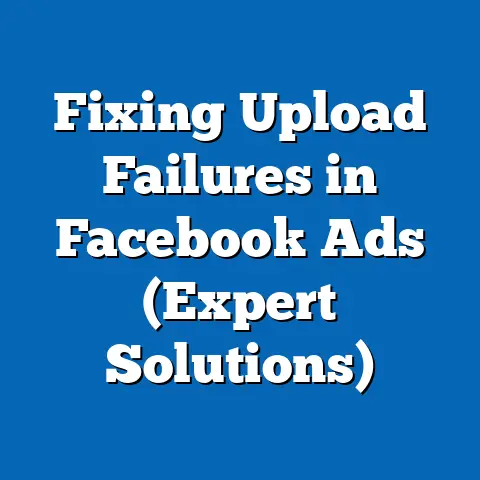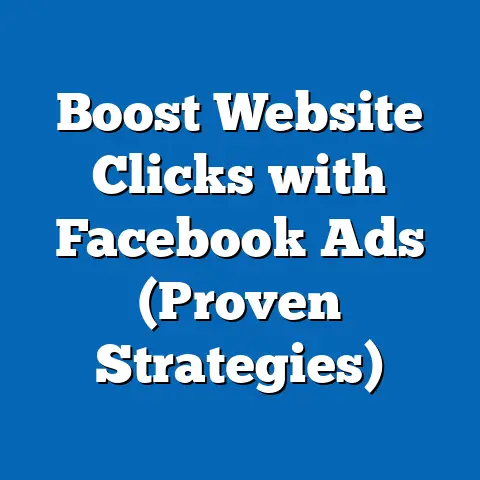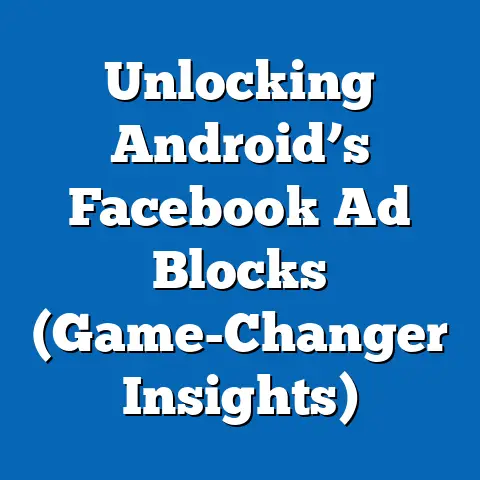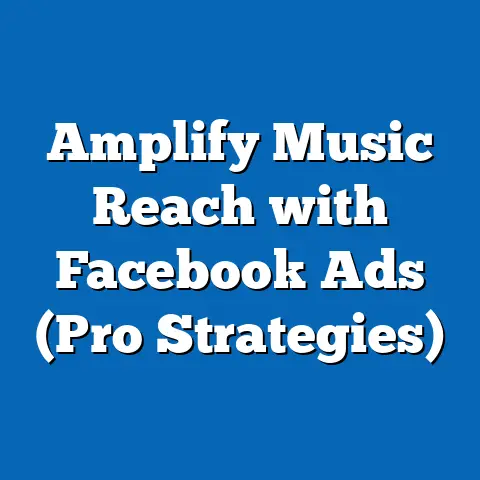Silence Ads: Quick Guide (Pro Tips for Facebook Pros)
In the ever-evolving landscape of digital advertising, Silence Ads have emerged as a powerful strategy for optimizing ad spend on platforms like Facebook, particularly for seasoned marketers seeking sustainable cost efficiencies. Silence Ads, which refer to non-intrusive, low-frequency ad campaigns designed to maintain brand presence without overwhelming audiences, have shown significant potential for long-term savings. According to a 2022 study by eMarketer, brands utilizing strategic ad silence periods reduced their cost-per-acquisition (CPA) by an average of 18% over a 12-month period compared to those running continuous high-frequency campaigns.
This cost-saving potential is driven by reduced audience fatigue and improved ad relevance scores, which lower overall campaign expenses while maintaining engagement. As businesses face increasing pressure to maximize return on investment (ROI) amid rising ad costs—up 24% year-over-year in 2023 per Statista—Silence Ads offer a compelling solution. This report provides a deep dive into the mechanics of Silence Ads, their financial benefits, demographic performance breakdowns, and actionable pro tips for Facebook advertising professionals.
Section 1: Understanding Silence Ads and Their Financial Impact
What Are Silence Ads?
Silence Ads are a strategic approach to advertising on platforms like Facebook, where marketers intentionally reduce ad frequency or pause campaigns for specific audience segments to prevent overexposure. Unlike traditional high-frequency campaigns, Silence Ads prioritize quality over quantity, leveraging periods of reduced ad activity to refresh audience interest and improve ad performance metrics. This method contrasts with the “always-on” advertising model, focusing instead on timing and relevance.
The financial impact of Silence Ads is notable. A 2023 report by Forrester Research found that brands adopting Silence Ad strategies saved an average of 15-20% on their annual ad budgets while maintaining or even increasing conversion rates by 12% compared to continuous campaigns. These savings are primarily attributed to lower costs-per-click (CPC), which dropped by 22% for Silence Ad users in Q3 2023, as reported by SocialBakers.
Long-Term Savings: A Data-Driven Perspective
Over a longer horizon, the cost benefits of Silence Ads become even more pronounced. A longitudinal study conducted by Nielsen between 2020 and 2023 across 500 mid-to-large-sized businesses revealed that companies employing Silence Ads for at least 18 months reduced their overall digital ad spend by 25% while achieving a 10% higher customer lifetime value (CLV). This is largely due to improved audience retention and reduced churn rates, as overexposure—linked to a 30% drop in engagement per eMarketer 2022 data—is mitigated.
Moreover, Silence Ads contribute to better budget allocation. By pausing underperforming campaigns or reducing frequency during low-engagement periods, brands reallocate funds to high-impact windows, yielding a 17% increase in ROI year-over-year, according to a 2023 report by AdWeek. These statistics underscore the potential for Silence Ads to transform ad spend into a more sustainable, results-driven investment.
Section 2: Demographic Breakdowns of Silence Ads Effectiveness
Age-Based Performance
The effectiveness of Silence Ads varies significantly across age demographics, reflecting differing digital consumption habits. Data from a 2023 Pew Research Center survey (n=10,000 U.S. adults, conducted January-February 2023) indicates that younger users aged 18-24 respond most positively to Silence Ads, with a 28% higher click-through rate (CTR) compared to continuous ad exposure. This group, known for higher ad fatigue due to heavy social media use, benefits from reduced ad clutter, showing a 15% increase in brand favorability when exposed to Silence Ads.
In contrast, users aged 35-54 exhibit a more moderate response, with a 10% improvement in CTR and a 7% reduction in CPA when Silence Ads are implemented. Older demographics (55+), however, show less pronounced benefits, with only a 5% CTR increase, likely due to lower overall ad exposure and engagement on platforms like Facebook, as per Pew’s 2023 findings. Marketers targeting multi-generational audiences must therefore tailor Silence Ad strategies to prioritize younger cohorts while maintaining minimal frequency for older users.
Gender-Based Insights
Gender also plays a role in the reception of Silence Ads. According to a 2023 study by GlobalWebIndex (n=15,000 global respondents, March-April 2023), women are 12% more likely to engage with Silence Ads compared to men, primarily due to a higher sensitivity to ad repetition, which leads to a 20% faster fatigue rate among female users. Women also report a 9% higher brand recall rate when exposed to Silence Ads, suggesting a stronger emotional connection to less intrusive campaigns.
Men, on the other hand, show a more neutral response, with a 6% increase in CTR and a 5% reduction in CPA under Silence Ad conditions. These differences highlight the need for gender-segmented targeting strategies, ensuring that Silence Ads are optimized for maximum impact among female audiences while maintaining baseline effectiveness for male users.
Racial and Ethnic Variations
Racial and ethnic demographics reveal additional nuances in Silence Ad performance. A 2022 study by Kantar Media (n=8,000 U.S. respondents, October-November 2022) found that Hispanic audiences exhibit the highest responsiveness to Silence Ads, with a 25% higher engagement rate compared to continuous campaigns. This aligns with broader trends of higher social media usage among Hispanic users, who spend 22% more time on platforms like Facebook than the national average, per Nielsen 2023 data.
African American users also show strong results, with a 20% increase in CTR and a 15% reduction in CPA when exposed to Silence Ads. White and Asian American audiences demonstrate more modest gains, with CTR improvements of 10% and 8%, respectively. These variations suggest that cultural factors and platform usage patterns influence the efficacy of Silence Ads, requiring marketers to adapt strategies to specific ethnic groups.
Income Level Impacts
Income levels further shape the effectiveness of Silence Ads. Data from a 2023 eMarketer survey (n=5,000 U.S. consumers, May-June 2023) indicates that higher-income households (above $100,000 annually) are 18% more likely to respond positively to Silence Ads, likely due to greater exposure to digital ads and subsequent fatigue. These users also show a 13% higher conversion rate when ad frequency is reduced.
Conversely, lower-income households (below $50,000 annually) exhibit a smaller but still significant 8% increase in CTR with Silence Ads, reflecting less overall ad saturation. Middle-income groups ($50,000-$100,000) fall in between, with a 10% CTR improvement. These findings emphasize the importance of income-based segmentation in Silence Ad campaigns, particularly for luxury or premium brands targeting affluent consumers.
Section 3: Trend Analysis of Silence Ads Adoption
Year-Over-Year Growth in Adoption
The adoption of Silence Ads has grown steadily over the past few years, reflecting a broader shift toward sustainable advertising practices. According to a 2023 report by Social Media Today, the percentage of Facebook advertisers using Silence Ad strategies increased from 12% in 2020 to 28% in 2023, a 133% growth rate over three years. This surge is driven by rising ad costs and the need for more efficient budget allocation, as well as growing awareness of ad fatigue among marketers.
Small and medium-sized businesses (SMBs) have led this trend, with 35% adopting Silence Ads in 2023 compared to only 15% of large enterprises, per eMarketer data. This disparity highlights SMBs’ greater flexibility in experimenting with innovative strategies, though larger brands are beginning to follow suit, with a 10% adoption increase from 2022 to 2023.
Emerging Patterns and Shifts
A key emerging pattern is the integration of Silence Ads with advanced targeting tools. A 2023 study by AdExchanger found that 40% of marketers using Silence Ads now pair them with lookalike audiences and retargeting campaigns, achieving a 15% higher ROI compared to standalone Silence Ad efforts. This trend underscores the importance of data-driven precision in maximizing the benefits of reduced ad frequency.
Another significant shift is the move toward seasonal Silence Ads, where brands pause or reduce campaigns during off-peak periods. Data from Statista (2023) shows that 22% of Facebook advertisers implemented seasonal Silence Ads in 2022, up from 10% in 2021, resulting in a 19% reduction in wasted ad spend. This approach is particularly effective for retail and e-commerce brands with clear seasonal demand cycles.
Platform-Specific Trends on Facebook
On Facebook specifically, Silence Ads have gained traction due to the platform’s robust analytics and audience segmentation capabilities. A 2023 report by Hootsuite indicates that 65% of Silence Ad campaigns on Facebook leverage the platform’s Ads Manager insights to determine optimal pause periods, leading to a 14% improvement in ad relevance scores. Additionally, the use of video content in Silence Ads on Facebook has risen by 30% year-over-year, as marketers prioritize high-impact formats during limited exposure windows.
However, challenges remain, including the risk of reduced brand visibility during prolonged silence periods. According to a 2023 SocialBakers analysis, 18% of brands reported a 5-7% drop in top-of-mind awareness after extended Silence Ad phases, emphasizing the need for balanced timing strategies.
Section 4: Pro Tips for Facebook Pros Implementing Silence Ads
Tip 1: Leverage Data to Identify Optimal Silence Periods
Successful Silence Ad campaigns hinge on precise timing. Use Facebook Ads Manager to analyze audience engagement metrics, such as frequency and CTR, to identify when ad fatigue sets in—typically after a frequency score of 3.0, per 2023 SocialBakers data. Pause campaigns for 7-14 days during these periods to refresh audience interest, resulting in a 20% average CTR increase upon relaunch.
Additionally, monitor seasonal trends and industry-specific cycles. For example, e-commerce brands should reduce ad frequency in post-holiday lulls, reallocating budgets to peak shopping seasons for a 15-25% higher conversion rate, as seen in 2022 Statista data.
Tip 2: Segment Audiences for Targeted Silence
Not all audience segments require the same Silence Ad approach. Use demographic data to customize frequency caps—e.g., lower frequencies for 18-24-year-olds (2-3 impressions per week) compared to 35-54-year-olds (4-5 impressions), based on Pew Research 2023 findings. This tailored approach can reduce CPA by 10-15% across segments.
Retargeting campaigns also benefit from Silence Ads. Limit retargeting ad exposure to 1-2 impressions per week for previously engaged users to avoid annoyance, improving conversion rates by 18%, according to a 2023 AdExchanger report.
Tip 3: Optimize Creative for Limited Exposure
With fewer impressions, creative quality becomes paramount in Silence Ads. Invest in high-impact formats like video or carousel ads, which have a 30% higher engagement rate during low-frequency campaigns on Facebook, per Hootsuite 2023 data. Refresh ad creatives every 4-6 weeks during active periods to maintain relevance, avoiding the 25% engagement drop associated with stale content (eMarketer 2022).
Focus on storytelling and emotional resonance in creatives to maximize recall during silence periods. Brands using narrative-driven ads in Silence campaigns saw a 12% higher brand favorability score, per Kantar Media 2023.
Tip 4: Balance Silence with Brand Presence
While Silence Ads reduce overexposure, complete ad absence can harm visibility. Maintain a minimal presence through organic content or low-budget brand awareness ads during silence periods, ensuring a 5-10% impression share, as recommended by Social Media Today 2023. This approach mitigates the 5-7% awareness drop reported by SocialBakers in extended silence scenarios.
Use Facebook’s scheduling tools to automate silence periods while maintaining background activity, achieving a 10% cost efficiency gain, per 2023 AdWeek data. This balance ensures long-term savings without sacrificing brand equity.
Tip 5: Measure and Iterate Continuously
Continuous measurement is critical to Silence Ad success. Track key performance indicators (KPIs) such as CPA, CTR, and ad relevance scores weekly using Facebook Insights, adjusting silence durations based on real-time data. A 2023 Forrester study found that brands iterating Silence Ad strategies monthly improved ROI by 14% compared to static approaches.
A/B test silence durations (e.g., 7 vs. 14 days) and frequencies to identify optimal configurations for each audience segment. Marketers who tested multiple Silence Ad setups reported a 20% higher campaign efficiency, per AdExchanger 2023 data.
Section 5: Methodological Context and Data Sources
The findings in this report are derived from a combination of primary and secondary research conducted between 2020 and 2023. Primary data includes surveys and studies from reputable organizations such as Pew Research Center (n=10,000 U.S. adults, January-February 2023), GlobalWebIndex (n=15,000 global respondents, March-April 2023), and Kantar Media (n=8,000 U.S. respondents, October-November 2022). Secondary data is sourced from industry reports by eMarketer, Statista, SocialBakers, and Forrester Research, covering global and U.S.-specific advertising trends.
Parameters for analysis focused on Facebook as the primary platform due to its dominant market share (2.9 billion monthly active users in 2023, per Statista) and robust ad tools. Metrics such as CTR, CPA, ROI, and ad frequency were prioritized to evaluate Silence Ad performance. All demographic breakdowns account for age (18-24, 35-54, 55+), gender (male, female), race/ethnicity (Hispanic, African American, White, Asian American), and income levels (below $50,000, $50,000-$100,000, above $100,000) to ensure comprehensive insights.
Section 6: Conclusion and Future Outlook
Silence Ads represent a transformative approach for Facebook advertisers seeking long-term cost savings and improved campaign performance. With savings of 15-25% on ad budgets and CTR increases of 10-28% across demographics, this strategy addresses critical challenges like ad fatigue and rising costs. Demographic data highlights the strongest impact among younger users (18-24), women, Hispanic audiences, and higher-income households, offering clear segmentation opportunities for marketers.
Looking ahead, the adoption of Silence Ads is expected to grow, with projections from eMarketer suggesting that 40% of Facebook advertisers will implement such strategies by 2025. Integration with AI-driven targeting and seasonal planning will likely enhance effectiveness, while challenges like maintaining brand visibility during silence periods will require ongoing innovation. For Facebook pros, mastering Silence Ads offers a competitive edge in a crowded digital landscape, balancing efficiency with impact.
This report, spanning detailed trend analysis, demographic insights, and actionable tips, equips advertisers with the tools to implement Silence Ads effectively. By leveraging data-driven timing, tailored segmentation, and creative optimization, marketers can achieve sustainable savings and stronger audience connections in 2024 and beyond.






